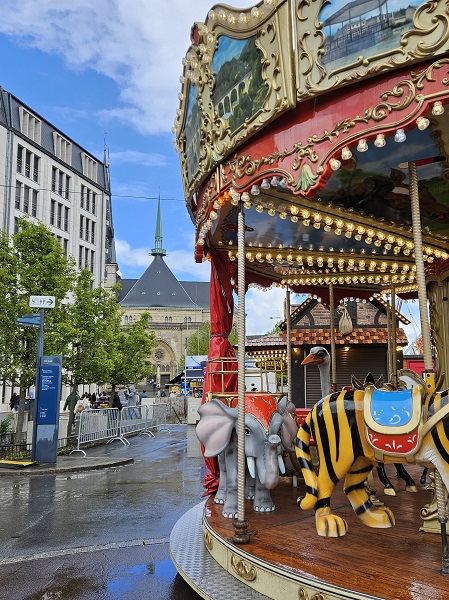 Octave pilgrimage closing procession in 2023;
Credit: SCP/D. Martins
Octave pilgrimage closing procession in 2023;
Credit: SCP/D. Martins
The April showers could not dampen the spirits of the crowds of people who flocked to Luxembourg City on Saturday afternoon.
The capital played host to various events on Saturday 20 April 2024, from the annual charity Duck Race to a DKV-UrbanTrail Nordic Walking event. Saturday also marked the start of this year’s Octave pilgrimage and the accompanying “Mäertchen” (Octave market), which will continue until Sunday 5 May 2024. The market is limited to one site again this year, namely the Place de la Constitution.
During this fortnight, people from across the Grand Duchy and the Greater Region embark on a pilgrimage to Luxembourg’s capital, where they can visit the wooden statue of the Virgin Mary (patron saint of Luxembourg City and the Grand Duchy of Luxembourg) in the Notre-Dame Cathedral before grabbing a bite to eat and some souvenirs from the Mäertchen.
Chronicle.lu had the opportunity to speak with Monique Weis, Full Professor in Early Modern History at the University of Luxembourg’s Institute of History, to learn more about this traditional pilgrimage. As Professor Weis explained, the “first traces” of the Octave pilgrimage date to 1624, making this year its 400th anniversary - albeit a somewhat unofficial one as it “took some time” for the pilgrimage to develop and become institutionalised.
The Jesuits, who played an important role in the (Catholic) Counter-Reformation, had settled in what was then the Duchy of Luxembourg - part of the Spanish Netherlands and bigger than today’s Grand Duchy. They set up a school (Collège des Jesuites) and a church (now the Notre-Dame Cathedral) in the early 17th century, and “encouraged new forms of religious practice and religious belief, especially linked to the Virgin Mary”. One Jesuit, Father Jacques Brocquart, commissioned a statue of the Virgin Mary to serve as protection against plague and for the northern fortifications in today’s Glacis; Father Brocquart brought Jesuit school pupils here to pray and he told tales of the miracles linked to the statue, which helped “make a success out of this pilgrimage”. Four years later, in 1628, a chapel was built in Glacis where the statue was housed until the end of the 18th century, when the pilgrimage was suppressed and the chapel destroyed. Since its revival in the 19th century, the statue has been kept in Notre-Dame Cathedral.
Professor Weis noted that the pilgrimage “evolved and became bigger” in the decades that followed its creation. It was institutionalised in 1666, when the political authorities appointed the Virgin Mary (Our Lady of Luxembourg, Consoler of the Afflicted), the patroness of the city of Luxembourg. Twelve years later, in 1678, she became the patron saint of the Grand Duchy of Luxembourg as a whole. “That was really a political decision,” noted Professor Weis. Then, in the late 18th century, “there was a lot of criticism of pilgrimages” and the Octave pilgrimage was suppressed. Luxembourg, which was used to having different foreign sovereigns over the centuries, formed part of the Austrian Netherlands before being annexed by the French Republic around this time. The Octave pilgrimage was revived in the 19th century before being forbidden (along with other public religious events) by the Nazi occupiers during the Second World War. In the aftermath of the war, however, Our Lady of Luxembourg (the Virgin Mary) became a “symbol of resistance”.
As its name suggests, the Octave pilgrimage originally lasted eight days but it is now spread over a fortnight between Easter and Pentecost. Professor Weis noted that it was quite unusual for a pilgrimage to be limited in time and thus to culminate in a “big procession” that is both “solemn” and “festive”. During this closing procession, the statue of the Virgin Mary (accompanied by other religious symbols) is carried through the streets of the capital. Whilst the political link to this religious event has become “more symbolic” than anything else, believers are joined on this occasion by representatives of the Grand Ducal family, the government, MPs and local politicians, among others.
Professor Weis added that people embarking on the pilgrimage tend to do so in groups, an idea that was “encouraged quite early”, as the Counter-Reformation promoted “collective piety”. She described the pilgrimage as a “multilayered experience”, both individual and collective, attracting people from all over the Grand Duchy but also areas such as the Belgian province of Luxembourg, Bitburg in Germany and Metz in France. "This success has been regional and it is also linked to the older borders of Luxembourg,” she commented.
Whilst Professor Weis would not describe the pilgrimage as “international”, its influence has spread beyond Luxembourg’s old borders: she explained how a small image of Our Lady of Luxembourg, purchased by Spanish soldiers at the Mäertchen in the 17th century, made its way to Kevelaer in North Rhine-Westphalia, Germany. A merchant’s wife purchased the image which became venerated in this town, which in turn has become one of the most important Marian pilgrimage sites in Germany.
Commenting on a piece she wrote in 2021 about the hybrid Octave pilgrimage, Professor Weis recalled that the motto that year had been “Suddenly everything is different” (Soudain, tout a changé) - a “well chosen” theme in light of the COVID-19 pandemic but also with the selection of a woman, Milly Hellers, for the first time, as the Octave preacher. This year’s motto is “To serve!” (Pour servir!) and, in another first, not just one but twelve preachers will deliver the sermons. The preachers are deacons with families (one will speak with his wife) and different professions.
Following mass on Sunday 5 May 2024, the last day of this year’s pilgrimage, the closing procession will kick off in the city centre at 15:00.

(Pictured: a children's carousel at this year's Mäertchen, with the Notre-Dame Cathedral in the background; credit: Jazmin Campbell / Chronicle.lu)








